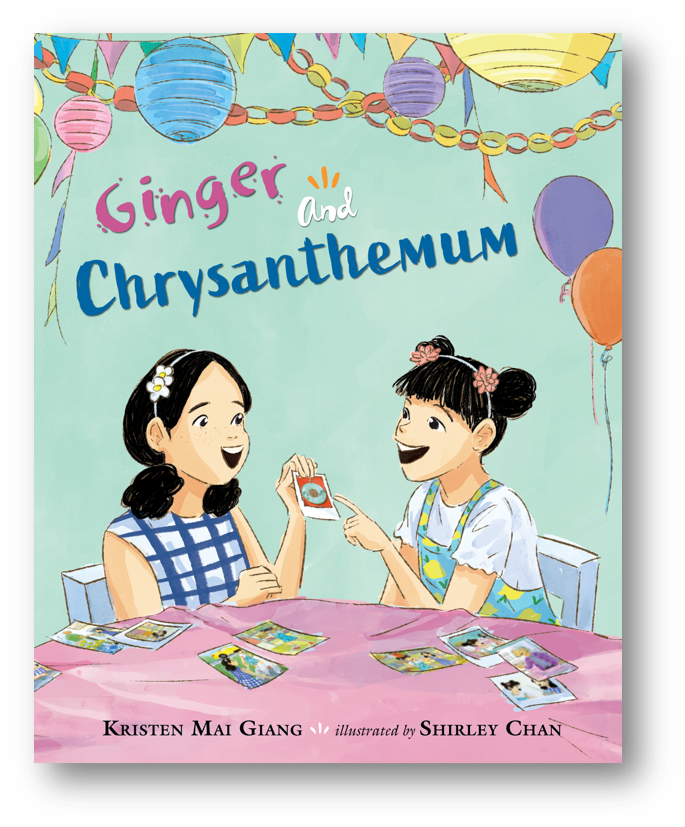First, a bit of housekeeping:
We’ll be taking a two-week break for the holidays, so look for our next new post in January.
We’re also changing our Newsletter schedule, so it will coincide with our Featured Author Interview post! Look for the Newsletter in your inbox the second week of the month. (Here’s our December Newsletter for those who haven’t seen it yet. If you like what you see, subscribe!)
You can also find our Holiday Gift Guide at Bookshop.org. (We use any affiliate proceeds to pay for website fees.)
Now, on to the post!
craft post by Anne-Marie Strohman
Lots of classic books have two main characters–Frog and Toad, Max and Ruby, Elephant and Piggie. I bet you can name some other favorites too.
These stories work well, especially in a series, because the differing personalities create built-in conflict. In order to figure out how to approach a story with two main characters, let’s look at Kristen Mai Giang’s Ginger and Chrysanthemum, illustrated by Shirley Chan, a contemporary story of two cousins who love each other but don’t always get along.
The Same, But Different
Giang begins not with how the two characters are different, but how they’re the same:
Ginger and Chrysanthemum are cousins. They’re as close as two beans in a pod.
Shirley Chan’s illustrations support their commonalities–the two girls face each other on opposite pages, they’re moving toward each other, they appear to be the same age, and though they do have physical differences from each other, they look like they’re related.
Linguists define opposites as things that have all but one thing in common–heavy and light are both weights, but one is a little weight and one is a lot of weight; narrow and wide are both measurements, but one indicates less distance between two things and the other indicates more distance.
Giang draws attention to that understanding of opposites. The two are the same, except for key aspects of their personalities. Here’s the full text of the first spread:
Ginger and Chrysanthemum are cousins. They’re as close as two beans in a pod. But that doesn’t mean they always get along.
The Contrast
The second spread contrasts the two girls, again by starting with a commonality:
Ginger and Chrysanthemum are so excited. It’s Grandma’s birthday. And her two little soybeans want it to be perfect.
The differences show up in how they approach planning the perfect party. Chrysanthemum makes a list and knows the perfect outfit, which she’s already picked out. Ginger can’t wait to dress up and tries on outfit after outfit, piling her rejected clothes on the floor. By showing the way both girls approach the same task, Giang shows the contrast between the two.
Cooperation and Conflict
In the early stages of the story, the two girls have contrasting personalities, but for the most part, they collaborate. They shop, pick out decorations, even agree on a present for Grandma. We also get to see the girls in action at their grandma’s restaurant, New Asian Kitchen, with Ginger banging away at the dumpling counter while Chrysanthemum carefully prepares tea.
The problems start when Grandma asks them to work together to make a green tea cake for her birthday party. Ginger has fiery ideas–“‘I’ll make an AMAZING cake with BLAZING candles!’”–while Chrysanthemum imagines making a cake that’s “light and cool as a cloud.”
Giang has set up a situation where they have the same goal but vastly different approaches. I won’t give away the hilarity that ensues and the sweet resolution. You can find the book at Bookshop.org, your local indie, big stores, as well as at your local library (and you can request they order it for the library if it’s not there) to read it for yourself.
Hot and Cold
In her author’s note, Giang shares her inspiration from the traditional Chinese belief that “foods have either warming or cooling characteristics . . . ideally creating balance.” Spicy Ginger and calm Chrysanthemum spring from these ideas. By choosing to base the characters on real life opposites (warm and cool), Giang made her job easier–she shapes their personalities around the quality of those opposites, and voilà! Built-in opposition.
Now it’s YOUR turn!
If you’re writing a story with two main characters,
- make a list of the ways the two characters are similar
- make a list of the main ways they’re different (this list might be the shorter one)
- brainstorm ideas for real-world opposites to use for inspiration
- write two or three scenes where the characters’ differences cause conflict
- write two or three scenes where their differences help each other
Once you have this pre-writing done, develop a story that incorporates both the similarities and differences between your characters.
If you missed our interview with Kristen Mai Giang, check it out here!
For more on developing characters, check out these posts.
Anne-Marie Strohman (co-editor) writes picture books, middle grade novels, and young adult short stories and novels. She is trained as a teacher, an editor, and a scholar, specializing in Renaissance Literature. She holds an MFA in Writing for Children and Young Adults from Vermont College of Fine Arts and is an active member of SCBWI. Find her at amstrohman.com and on Twitter @amstrwriter.

COMMENTs:
0